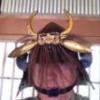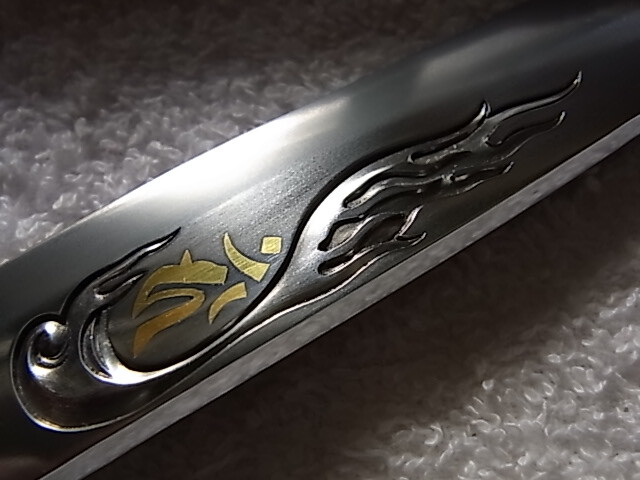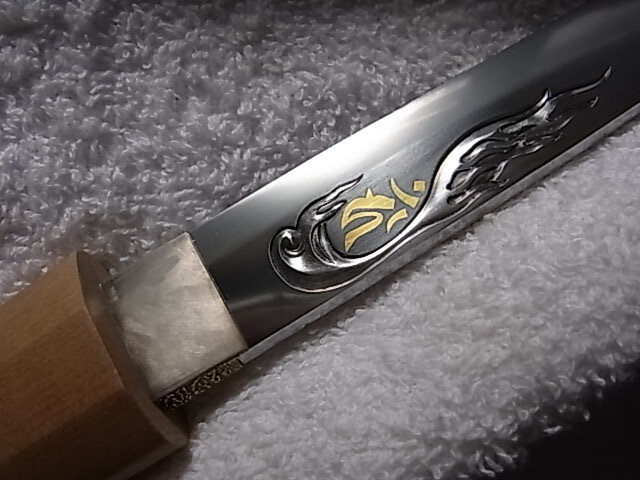-
Posts
13,722 -
Joined
-
Last visited
-
Days Won
246
Content Type
Profiles
Forums
Events
Store
Downloads
Gallery
Everything posted by Bugyotsuji
-
Guido, to be more precise, my electronic dictionary gives no Chinese root for it, and further adds, 杉の崩れたもの
-
Tim, this one is actually not too difficult. Let us know how much you CAN read and then people will probably fill you in!
-

Horimono examples on blade
Bugyotsuji replied to Bugyotsuji's topic in General Nihonto Related Discussion
Mark, Brian, Jacques, Eric, Ian, Henk-Jan, Franco, many thanks for the beautiful examples. The more you stare at them , the more they seem to be frozen in some ghostly ethereal three-dimensional world. If I miss a name or fail to comment on someone's offerings, please know that many people are looking at and enjoying this thread. (Well, looking anyway! :lol: ) -

Horimono examples on blade
Bugyotsuji replied to Bugyotsuji's topic in General Nihonto Related Discussion
Lovely. There must be something really satisfying about carving beautiful figures in steel, especially when you are confident. One of my friends has just become independent after training for several years. He has taken several top prizes. I believe he charges something like 1 million JPY for a comprehensive horimono into a long blade, but it might take him several months to do it. Even then it would hardly be enough to keep him alive. (Henk-Jan, your comment above suggests you knew about Yanagimura Sensei before.)(?) PS Surely a good sukashi horimono would lighten the blade, but also take into account the stresses incurred in actual use. That is, a hori that ignores inner directional forces could well be considered a bad carving. (Just throwing out ideas here.) -
That form of the 杉Sugi Kanji is/was mainly used only in people's names, according to my electronic dictionary.
-

Horimono examples on blade
Bugyotsuji replied to Bugyotsuji's topic in General Nihonto Related Discussion
Acquired this Kaiken tanto recently. Struggled with the lighting a bit... "Kaen no naka no Fudo-Myo-o". Yanagimura Senju, on blade by Tosho Kanbayashi Tsunehira. Nakago signed Senju. http://www.nihonntou.net/newpage5.htm -

Horimono examples on blade
Bugyotsuji replied to Bugyotsuji's topic in General Nihonto Related Discussion
Amazing! Those scales are something. -

Horimono examples on blade
Bugyotsuji replied to Bugyotsuji's topic in General Nihonto Related Discussion
Thanks for that, Mark. A beautiful work. The Ken is stunning. Three words by the senior Mr Yoshikawa, traditional, minute and skillful. So guessing the original Japanese they are carved to a (伝統的な)traditional formula, they are carved in (細かい) minute detail, and they are (熟練した、上手に) skillfully done. And he reckons it has improved the blade. I have seen artisans working on genuine old blades and marvel at their confidence. I once saw an NHK documentary about a famous carver who was trying to teach his son to follow his footsteps. When the dragon was complete, it was time to do the eyes, the most important part. The son was baulking/balking and sulking, completely unable to do it. All he could do was smoke cigarettes, refusing to take the next step. His father finally invited him to take a walk in the park and stopped by some Sakura trees in full blossom. "Look at this", he said. "The secret to the eyes is hidden in this flower." His son stared at the flower and slowly recognition dawned. He felt able to go back to the workshop and start work on the dragons' eyes. His father was even pleased with the result. -
Mark, the MCI is the Meinertzhagen Card Index (of all the Netsuke in the British Museum?). It comes in two books and usually costs well over 1,000 USD if you can even find a copy. One of the two 'bibles' of Netsuke. You might want to spend some time over on the International Netsuke Society site too, where there is a ton of information and an active forum. http://netsuke.websitetoolbox.com/
-
Just had this conversation with a couple of other members of our local sword appreciation society. Is it really true, or an article of faith? They laughed and agreed. They said it is very difficult to see 'color/colour' in a lone blade, but side by side as Paul says above, the job becomes easier. I was staring at an Aoe blade after the sensei mentioned its typical black quality, and well, just perhaps it had a bluish tinge to it, I was thinking. :lol:
-
Unable to find a dedicated thread to Horimono, the search machine coming up blank, I decided to start a new one. If this is a repost Mods, please move/delete as necessary. Horimono can have a multitude of functions. Ideally they should improve the value and look of the blade, though purists might object to any carving within the blade itself. Some people love them, others hate them. Horimono have been used to cover a multitude of sins, too, I understand. Horimono can be old or new, carving talent not being limited to any century. Would people be interested in posting shots of their Horimono? (They may be difficult to shoot.) It would be a learning experience for me, especially if you can accompany the photograph with comments/readings/thoughts as to why it might interest the hono(u)rable members here. Thank you.
-
Be careful though as there were (perhaps other, possibly the same person) carvers using the name Ryuchin who did not use either of those Kanji. eg 龍珍 In this case there is a nice example in the MCI, p.667, Entry no. 1709, with the same characters and the same seal as yours. (N.Davey in NETSUKE does not record an example of a Ryuchin with your way of writing, BTW)
-

CLEANING A LACQUERED YUMI
Bugyotsuji replied to watsonmil's topic in General Nihonto Related Discussion
Ron, I forgot to mention that the bloke who sold me on this stuff insisted on the use of microfibre (microfiber) cloths. They pick up minute traces of dirt and prevent surface scoring or minute scratching apparently. Not being a housewife I had to go and find out what they were before laying in a stock of them. -
Is that a three-toed dragon? And a Shishi-botan or Botan-jishi, the popular combination motif of Peony and Shishi lion.
-

CLEANING A LACQUERED YUMI
Bugyotsuji replied to watsonmil's topic in General Nihonto Related Discussion
Half an hour later. After shots -

CLEANING A LACQUERED YUMI
Bugyotsuji replied to watsonmil's topic in General Nihonto Related Discussion
Well, as an experiment I cleaned an old lacquer kiseru-zutsu with the magic gunk just now. The tube was badly damaged but there are the remains of two masks on the side which caught my eye. I had shown it to a few people but they just sniffed. So tonight I cleaned it and made some discoveries under the filth. Three before shots. -

CLEANING A LACQUERED YUMI
Bugyotsuji replied to watsonmil's topic in General Nihonto Related Discussion
For cleaning lacquer I use a magic liquid for cleaning cars. In Japan I use Plexus, plastic cleaner, protector and polish, but the name of the stuff I use in the UK escapes me. It cleans surfaces of glass, ovens, mirrors, cars, etc. Recommended for painted surfaces, plastics, resins, shielding, acrylic resins, polycarbonate, FRP, ABS (poly) vinyl chloride resin, films, CDs, DVDs etc. People are super paranoid about the paint and surface lacquer on their pride and joy, (automobile) so this cannot be too far off. Sadly I do not know anything about the long-term effects, so if you are not sure, please experiment with it on a different piece of lacquer first. I find that alcohol etc. may clean it, but it can tend to dry it out and lose even more of that lovely deep liquid glossiness of lacquer. As to obvious patches where the lacquer has already flaked off, there is a laquer-like paint called 'cashew' here in Japan, but it tends to be too shiny once dry. Some people mix 'tonoko' with it to lose the luster/lustre. Someone showed me a trick with a matt (black) quick-drying water-based acrylic (?) paint. It helps blend the bald patches into the general background and looks good from almost any distance. Great for home displays, but not recommended for museum standard renovations. The matt is not a problem; the repaired article looks actually better than having lacquer or lacquer-alternative glossy patches here and there. Old red lacquer fades easily, so it can be more of a problem to harmonize. -

This Week's Edo Period Corner
Bugyotsuji replied to Bugyotsuji's topic in General Nihonto Related Discussion
Hey Eric, it worked! Many thanks. (Brian gave me enough of a hint but I am pretty much useless when it comes to computer programming so I took it literally and simply gave up.) -

This Week's Edo Period Corner
Bugyotsuji replied to Bugyotsuji's topic in General Nihonto Related Discussion
I went back to edit the link as you suggested Brian, but the rejection carried this message: "It was not possible to determine the dimensions of the image." -

This Week's Edo Period Corner
Bugyotsuji replied to Bugyotsuji's topic in General Nihonto Related Discussion
Forgive me for the further thoughts, but you could ask why the sudden warmth towards a lone sniper of 250 years before? Well, this gun could have been made as a symbol of renewed hatred not so much for the foreign barbarian, (Nariakira Shimazu admired the West) but against anyone supporting weak-kneed rapprochement, and especially the Ii clan as Chief Minister of Japan Ii Naosuke pushed for opening Japan to the West, particularly with the signing of the Harris treaty in 1858. The Sakurada Gate incident has Arimura Jisaemon, another lone agent of Satsuma ganging up with the Mito Ronin, and cutting Ii Naomasa's neck. http://en.wikipedia.org/wiki/Sakuradamon_incident_(1860) ***The link is odd, the closing bracket gets left off; you may have to click again on the linked page. Sadly for the gun story though, because as we gain love and respect for Kashiwagi, we correspondingly lose the strong connection with Bizen. Unless... Nariakira's favorite target pistol of the 1840s was decorated in later years with a silver plate to celebrate how Kashiwagi had once killed a leader of the Ii family... (?) Did Shimazu see Western guns, Ian, and get the idea for the placement of the family silver? -

This Week's Edo Period Corner
Bugyotsuji replied to Bugyotsuji's topic in General Nihonto Related Discussion
Many thanks for the extended lease of life... I am now breathing a little more easily! :lol: PS The actual gun that Kashiwagi is said to have used is still preserved in the Kawakami family of his immediate superior in the ranks, Kawakami Shirobei Tadae, and this gun is still given as a reference point for scholars, an example of a very rare but extant early(-ish) long gun. -

This Week's Edo Period Corner
Bugyotsuji replied to Bugyotsuji's topic in General Nihonto Related Discussion
Ian, as always many thanks for your valuable input. From what I have seen of Japanese pistols, they are boxed horizontally but upright, (not as in the West on their sides), or when displayed in houses or museums, on stands, again horizontally but upright. Matchlock pistols are so rare even in Japan, that I have never actually seen any on a rack, or even such a thing as a pistol rack itself for that matter. Naturally what you say about pistols in the west rings true. I was so tempted by a 'flintlock of Nelson's navy' as the London dealer liked to call it. It had some numbers stamped upon it and must have lived in a locked cabinet to be handed out to a member of the crew before action. Battered and bruised and repaired all over, I would not be at all surprised if it had been used for cracking walnuts. :lol: You are not going to try and make out it is a Mon after all, I hope. My whole lovely story would go down like the Concordia... :| and you don't know how many hours and days and weeks I have been gathering snippets. If it is a Kamon, everything goes back to square one. I am now beginning to think that the reason I was allowed to buy it in the first place is that no-one can come up with a suitable explanation for the silver disc. They know I enjoy a hunt, and rooting out truffles, so I must believe that they are allowing me to run with it for a while. If I can make a plausible story I will write it up in succint Japanese and see if they are interested in displaying it with the item at the exhibition. I can just see them saying "No!" -

This Week's Edo Period Corner
Bugyotsuji replied to Bugyotsuji's topic in General Nihonto Related Discussion
It is recorded in the annals of Ii, that the bullet ricochet(t)ed off Naomasa's armour and pierced his arm as he was holding aloft his sword. He stayed on his black horse as long as he could but finally rolled off in agony. He never recovered from the wound. In 1769 a stone monument was erected to the hero Kashiwagi Motohisa to ease his soul at the Nanrinji Temple in south Kyushu. The inscription avoids using his earthly name, but suggests that when he heard of the death of Ii Naomasa 18 months later, he donned black garb and wandered the country, never to marry or have children and never more to return to his place of birth. *Gen-katsugi is a colloquialism meaning 'for luck'. I wear red underwear when racing on the circuit, for example. Gen wo katsugu, ie to garner good luck. -

This Week's Edo Period Corner
Bugyotsuji replied to Bugyotsuji's topic in General Nihonto Related Discussion
Yesterday in the car on the way to the sword meeting I showed the photos and asked for opinions. One member of the party said, "*Gen-katsugi? Why not? Perfectly reasonable." The story I would like it to be and can half see is that the young Shimazu Naritoshi 1811-1842, who became 7th Lord of Okayama/Bizen, ordered a gun to be made by Tatsuemon Sukenobu for his elder brother, Nariakira 1809-1858, 28th Lord of Satsuma. A good present? The whole country was under orders to re-arm, and the enemy was likely to approach from the south of Kyushu. The gun would be the very best of Bizen, but incorporating Satsuma sentiment. At 65.5 cm, a Kago-zutsu, but much slimmer, designed as a Shageki-ju. The mark underneath would recall the time the family was protected while retreating from Sekigahara when 22-yr-old 'dead-shot' Kashiwagi broke ranks and felled Ii Naomasa from his horse as, under direct orders from Tokugawa Ieyasu, he was leading the following combined Ii + Honda charge to destroy Satsuma. The fall of Ii Naomasa signalled a general pull-back and the remaining Satsuma forces were able to make their escape. The two brothers must have loved this story as children. Could such a silver plate have meant both protection for the family and a wish for accuracy in shooting? Since the Lord Ikeda Naritoshi died in 1842, it could be that the gun he ordered was only completed after his death... (?) but here we further enter the world of speculation. It is well used, so perhaps Nariakira used it in fond memory? -

This Week's Edo Period Corner
Bugyotsuji replied to Bugyotsuji's topic in General Nihonto Related Discussion
Well, however you cut that story, it's a good one and rings true. Two updates. One is on the 'gold' powder. Having read Ian's description of Dutch gold as brass, 84% copper & 16% zinc, the powder that I bought suddenly looked somehow more reddish to me as I opened the lid. It was only an experimental job to paint gold lines on the edges of the gun stand, but I mixed up far too much of both the acrylic lacquer and the powder and had to wander around the house looking for any gold-colored/coloured things that needed a patch-up, like the shikoro on my kabuto. Reddish gold, Welsh gold(?) is now the flavour of the month, but using it has taught me probably 90% of what I needed to know. The other is regarding the Daimyo pistol. The use of Kashiwa oak leaves around the Satsuma Kutsuwa cross has had me flummoxed, but gradually I am clawing back some hints with which to build a circumstantial case for a story. The question is whether I should let it out in globs here, or tie it all together and publish it in some form. If it is indeed a target pistol, as Ron says, then the case for the mark being talismanic as I suggested earlier in this thread is strengthened. Mon or Kamon tended to be placed where they could be seen, either all the way down the sides of the butt and stock, or on the top and/or upper sides of the barrel. This silver plate is hidden, though, underneath the gun where only the owner or the loading party would normally see it. What I wanted was a strong tie-in between these two seeming Mon. What I have found is that the Shimazu family owe(d) their very existence to a young man named Kashiwagi, 柏木(or Kashiwada 柏田 in some versions) an 'elite sniper' as he is described in Japanese blogs on the internet. His family crest was the three 柏 oak leaves.





